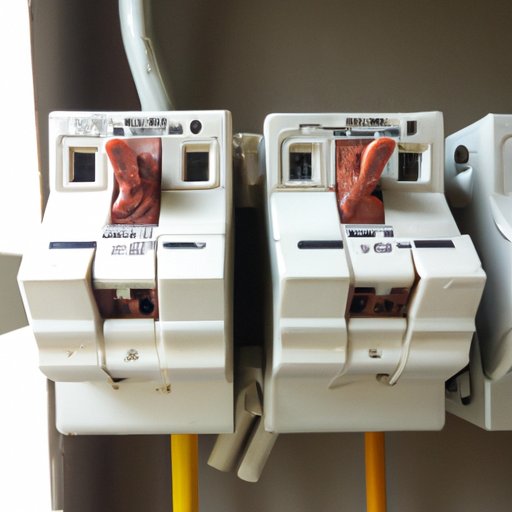Introduction
A circuit breaker is an important device in your home’s electrical system. It is designed to protect you from dangerous electrical shocks, as well as potential fire hazards. When a circuit breaker trips, it shuts off the flow of electricity to that circuit. But why does a circuit breaker trip in the first place? In this article, we will explore the common causes of tripping circuit breakers and how to prevent them in the future.
Exploring the Causes of Circuit Breaker Tripping
The most common cause of a circuit breaker tripping is an overloaded circuit. This happens when too many appliances are plugged into one circuit. The circuit becomes overloaded and the circuit breaker trips to prevent an overload on the wiring, which could potentially lead to an electrical fire.
Short circuits can also cause circuit breakers to trip. A short circuit occurs when there is an unintended connection between two wires in the same circuit. This connection creates a pathway for electricity to flow without resistance, causing the circuit breaker to trip.
Ground faults can also cause circuit breakers to trip. A ground fault is an unintentional connection between a hot wire and a neutral or ground wire in the same circuit. This connection can cause an overload on the circuit, resulting in the circuit breaker tripping.
Electrical arcing can also cause circuit breakers to trip. Arcing occurs when there is a spark between two wires in the same circuit. This spark can cause an excessive amount of heat, which can overload the circuit and cause the circuit breaker to trip.
Loose connections can also cause circuit breakers to trip. If the connections between wires become loose, they can create an abnormal current flow, which can overload the circuit and cause the circuit breaker to trip.

What to Do When Your Circuit Breaker Trips
If your circuit breaker trips, the first thing you should do is reset the circuit breaker. To do this, simply switch the circuit breaker back to the “on” position. If the circuit breaker trips again, then you should check for physical damage to the circuit breaker or wiring. If everything appears to be in good condition, then you should reduce the load on the circuit by unplugging some of the appliances connected to the circuit.
How to Troubleshoot a Tripping Circuit Breaker
Once you have reset the circuit breaker and reduced the load on the circuit, you should begin troubleshooting the tripping circuit breaker. Start by checking all of the appliances connected to the circuit and make sure they are in good working order. You should also test the wiring to make sure it is not damaged or frayed. Finally, inspect and clean the circuit breaker to make sure it is functioning properly.

Avoiding Common Mistakes That Cause Circuit Breakers to Trip
To avoid tripping circuit breakers, it is important to avoid making common mistakes. One of the most common mistakes is overloading circuits. Make sure that you do not plug too many appliances into one circuit. It is also important to avoid using too many extension cords, as this can also overload the circuit. Finally, make sure to use ground-fault circuit interrupters (GFCIs) in wet areas to protect against electrical shocks.

Understanding the Role of Circuit Breakers in Home Electrical Safety
It is important to understand the role of circuit breakers in home electrical safety. Circuit breakers protect against electrical fires by shutting off the flow of electricity when an overload occurs. They also help protect against electrocution by cutting off the power when a ground fault occurs. Finally, they can help protect against power surges, which can damage electronics and appliances.
The Benefits of Regularly Testing and Maintaining Your Circuit Breaker
Regularly testing and maintaining your circuit breaker is important for ensuring proper operation and avoiding costly repairs. Testing and maintenance helps identify any issues that may be causing the circuit breaker to trip, such as loose connections or worn out wiring. It also helps to reduce the risk of electrical fires by ensuring that the circuit breaker is functioning properly.

Tips for Preventing Circuit Breaker Trips in the Future
To prevent circuit breaker trips in the future, it is important to follow a few simple tips. First, never overload circuits by plugging too many appliances into one circuit. Also, keep wiring and outlets in good condition to avoid shorts and ground faults. Additionally, use surge protectors to protect against power surges. Finally, regularly check and maintain your circuit breakers to ensure proper operation.
Conclusion
In conclusion, circuit breakers are essential components in home electrical systems, protecting against electrical fires, electrocution and power surges. The most common causes of circuit breaker trips are overloads, short circuits, ground faults, electrical arcing and loose connections. To prevent circuit breaker trips in the future, it is important to avoid overloading circuits, use surge protectors and regularly check and maintain your circuit breakers. Remember to always practice electrical safety and test your circuit breakers regularly.
(Note: Is this article not meeting your expectations? Do you have knowledge or insights to share? Unlock new opportunities and expand your reach by joining our authors team. Click Registration to join us and share your expertise with our readers.)
